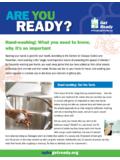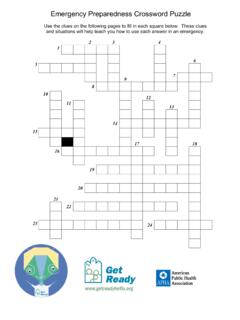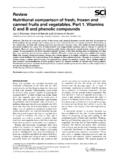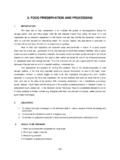Transcription of Your emergency preparedness stockpile: What you need to …
1 your emergency preparedness stockpile: What you need to knowEmergencies such as tornadoes, floods, storms, earthquakes or even disease outbreaks can happen unexpectedly. You may be without electricity, refrigeration, clean tap water or phoneservice for days or weeks. In some cases, such as during a disease outbreak, you may be askedto stay home to keep safe. That s why having an emergency preparedness stockpile is Americans should have at least a three-day supply of food and waterstored in their homes, with at least one gallon of water per person per day. Ifyou have the space, experts recommend a week s supply of food and foods that don t require refrigeration and are not high in salt. Yourstockpile should also contain flashlights, a manual can opener, a radio, batteriesand copies of important documents. Depending on your family s needs, you may also need medical supplies, pet food, contact lens solution or it s too expensive for you to buy everything for your stockpile at once, pickup one or two items every time you go to the grocery store.
2 Stock up on cannedvegetables or batteries when there is a sale. Bulk club storescan also help you save money on your supplies, especially if yousplit a case with a friend, co-worker or neighbor, who can serveIt s best to store your stockpile somewhere that is easy to access during an emergency . A cool, dark place is ideal. Be sure not to store your food close to any solvents or cleanersthat can leak or transfer fumes, or in an area of the house that is at risk for your supplies together in a box or plastic bin that can be kept tightly closed to protect contents from humidity or pests. It s also handy to keep all your supplies together incase you have to evacuate quickly, such as during a hurricane. In a pinch, a laundry basketcan make an easy storage you live in an apartment or small home and are short on space, be creative. Compactwrapping paper bins can be used to store canned food.
3 Risers can make more space underthe bed. Many people also have unused space behind or under the sofa. Have a dishwasherbut don t use it? Make the most of the empty space by storing your supplies there! as your preparedness buddy. Once you ve assembled your stockpile, put it where you won t be tempted to borrow from it the next timeyou run out of batteries or need beans for a recipe. Remember: your stockpile is for emergencies!How do I store my emergency preparedness stockpile?What should I put in my emergency preparedness stockpile?When it s time tochange your clocks fordaylight saving time,check your emergencypreparedness anything that isexpired or RReadyStockpiling TTipIt s best to check your emergency preparedness stockpile onceor twice a year. If you need a reminder, take a lesson from APHA sGet Ready: Set your Clocks, Check your Stocks campaign. Whenit s time to change your clocks for daylight saving time, take a lookat your emergency preparedness stockpile.
4 Discard anything thathas expired or is leaking or damaged. If you ve borrowed itemsfrom your stockpile, make sure to replenish them. Place the neweritems in the back of your stockpile and rotate the older items to thefront. You can even use stickers to mark the dates when you addedsupplies to your t forget to check the batteries in your smoke detectors aswell when you change your clocks!The easiest way to tell if your foods are still usable is expiration water can go bad eventually, so look for the stamped date on yourwater containers. Experts recommend rotating your bottled water supplyevery six canned foods don t have expiration dates or have dates thataren t legible. So how to tell if the food is still good? According to the of Agriculture, high-acid canned foods such as tomatoes,grapefruit and pineapple can be stored for a year to 18 months. Low-acidcanned foods such as meat, poultry, fish and most vegetables will keeptwo to five years if stored expiration dates, you should physically examine the contents ofyour stockpile to make sure they are still fresh.
5 Check that none of yourboxes or food containers have signs of pests or have been crushed or haveopened. On cans, look for rust, bulging, punctures, dents or leaks. Nevereat any food if its packaging or contents has come into contact with floodwater or has been in a fire. Look for leaks or corrosion on batteries anddispose of them carefully, recycling them if often do I need to refresh or rotate my stockpile?How can I tell if the supplies in my stockpile are still good?For more tips on creating your emergency preparedness stockpile, visit Flashlight and batteries Manual can opener Battery-operated radio (and batteries) or hand-cranked radio Matches in waterproof container Utility knife Paper and pencil Cash, traveler s checks and coins Paper cups, plates, plastic utensils, paper towels Garbage bags Pet food Whistle Small, canister ABC-type fire extinguisher Needles, thread Plastic sheeting Duct tape, scissors Extra set of keys and IDs Local mapsMy emergency preparedness stockpile checklistPack the following items in a clearly labeled, easy-to-carry, sealable container and store them in a place that is easy to access.
6 Check your stockpile once or twice a year. A good rule ofthumb is to check your stockpile when you change your clocks for daylight saving any supplies that are missing or have expired or have been and waterEmergency supplies Small tent, compass and shovel Household chlorine bleach and medicine dropperWhen diluted nine parts water to one part bleach, this can be used asa disinfectant. In an emergency , you can use it to treat water by using16 drops of regular household liquid bleach per gallon of water. Donot use bleach with added cleaners or bleach that is scented. Three days worth of drinking water, with one gallon of waterper person per day. Do not stockpile soda. Three-day supply per person of non-perishable foods. Take into consideration special dietary needs. Avoid salty foods that make you thirsty and include canned foods with highliquid content. First aid manual Bandages, including gauze and bandage tape Germicidal hand wipes or alcohol-based hand sanitizer Antiseptic wipes Non-latex gloves Antibacterial ointment Scissors (small, personal) Tweezers CPR breathing barrier, such as a face shield Prescription medications (such as heart and blood pressure med-ications or asthma inhalers)
7 And medical supplies, such as insulinand blood-pressure monitoring equipment, if applicable Non-prescription medication, such as acetaminophen, ibuprofen, anti-diarrhea medicine, antacids and laxativesFirst aid and emergency medical kitPersonal itemsFor more tips on creating your emergency preparedness stockpile, visit Extra prescription eyeglasses, if applicable Denture and contact lens supplies, if applicable Hearing aid batteries, if applicable Diapers and infant supplies, if applicable Sleeping bag or warm blanket for each bedding if you live in a cold-weather climate. Complete change of clothing for each person,including a long-sleeved shirt, long pants and sturdyshoes. If you live in a cold climate, add jacket or coat, hat, mittens and scarf. Moist towelettes, feminine hygiene supplies, latexgloves and other items for personal sanitation Birth, marriage and death certificates Insurance policies and will Contracts, deeds, stocks and bonds Passports, Social Security cards Immunization recordsImportant documents: Store in waterproof, portable container Bank account numbers, credit card account numbers and company contact information Prescription information Inventory of valuable household goods Veterinary records for pets, as well as pet photosEmergency preparednessstockpile grocery listEvery American should have at least athree-day supply of food and water stored intheir home, with at least one gallon of waterper person per day.
8 If you have the space,experts recommend a week s supply of foodand water. Choose foods that don t requirerefrigeration and are not high in salt. Yourstockpile should alsocontain flashlights, aradio, manual canopener, batteries andcopies of importantdocuments. Dependingon your family sneeds, you may also need medical supplies,pet food, contact lens solution or it s too expensive for you to buy every-thing for your stockpile at once, pick up oneor two items every time you go to the grocerystore. Stock up on canned vegetables or bat-teries when there is a sale. Bulk club storescan also help you save money on your sup-plies, especially if you split a case with afriend, co-worker or neighbor, who can serveas your preparedness buddy. For more tips on creating your ownemergency preparedness stockpile, t Re ady Grocer y Shopping List Bot tled water Canned juice Canned or boxed milk Canned fruits and vegetables Green beans Corn Pe a c h e s Fruit cocktail Pe a rs Pineapple Peanut butter and jelly Canned pasta or spaghetti Crackers (look for low-sodium) Canned meat and fish Chicken Tu r k e y Tu n a Vienna sausages Salmon Soups (look for low-sodium) Dried f ruit Protein drinks Granola bars Dried cere al Nuts (unsalted, preferably) Cookie s, candy bars, hard candyCheapstoc kpiling:Howto bepreparedona budgetWhe n mon ey is tight, addi ng extra itemsto your shoppinglist can be ha rd.
9 How ev er , with a bitof plan ni ng , th ere are lots of way s to bui ld your emergencypreparednesssupp li es on a budg r fir st st ep shouldbe to look at an eme hel p yo u get an ide a of the di ffere nt thingsthat shouldgo in an emergencypre par ed nesskit and he lp you comeup with a plan for buildingyour own gh th e list may see m daunting at firs t, you lllike ly find that you alrea dy owna lot of th e item s you l l want to incl ude in your kit. Startthe process by pullingtoge the r it ems that you ha ve on han d at example,you may haveenoughcan ned good s to sta rt your fo odst oc kpi le or ext ra ba ndag es th at can go into your emer gen cyfirs t ai d ki t. Onceyou ve pu lled to gethe r the itemsyou have,che ck them of f the list an d star t ma king a plan for the others.
10 As you bui ld yourpre pa re dnes s kit , don t fe el lik e you ha ve to do it al l inone day . It wi ll lik el y be ea sier on yourbudget if you spre ad out the item s overse ve ral wee ks or sid er ad ding a few ex tra dol la rs to your wee kly shopping tr ip andbuy jus t a few it em s ea ch ti me you go to the store . Another imp or ta nt th in g torem em ber is to kee p an eye out for sa le s. Ca rry your che ckl is t wit h yo u so yo u llkn ow wh at yo u st ill needwhe n you fi nd a goodde al .Tak e a lesson fromfamil ie s tha t sav e ongrocerie s re gula rly by shoppingat stores tha t off erdouble couponsand by buy ing gene ric . Cannedfoo ds are ofte n le ss ex pens iv e to stoc kpile tha nSa ve on sp ac e by stori ng your supplie s in containers you alre ady have. Th at plasticbin that held yo ur ch ildren sto ys whenth ey wer e yo un g or a laundrybas ke t tha t is no longerusedcan be comethe perfect orga art with the supplies you alreadyhaveBui ld you r kit a littlebit at a ti meotherready-to-eat she lf food,but wa tch out for high don t wa nt food s in yourstockpil e that wil l ma ke you thi rsty , as clea n wate r supplies ma y be lim it ed duringan emergencyor goodopti on for savi ng money is to look for dealsat bulk groc erystores.









